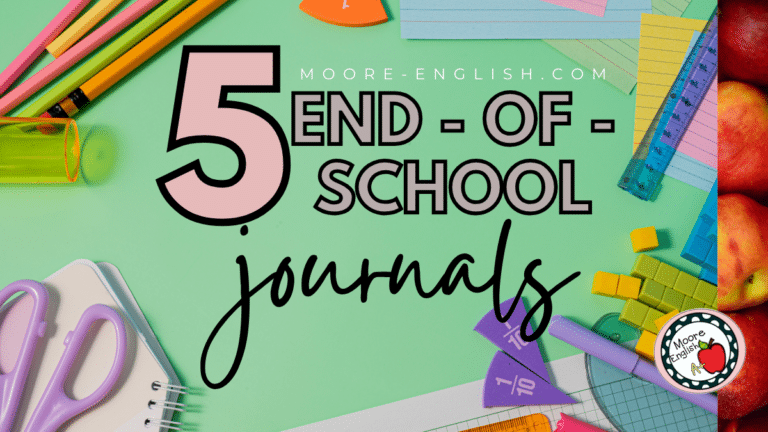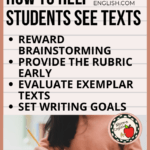Visualization is one of my favorite classroom strategies. We use visualization with synthesis thinking, drama, and reading. Sometimes, though, it’s hard to help students visualize with their own writing. How can teachers help students conceptualize their final written product? Over the years, I’ve come to value these steps to helping students visualize their writing.

This post this post may contain affiliate links. Please read the Terms of Use.
Visualizing Brainstorming
Reward Brainstorming As a student, I always used my own techniques for brainstorming. And I resented teachers that required me to brainstorm in a certain way or with a specific graphic organizer.
For this reason, as a new teacher, I vowed to never require my students to brainstorm. That was a mistake.
When my students didn’t take time to brainstorm, they produced disorganized or incoherent writing. This happened because they struggled to visualize their end goal.
Reluctant to require brainstorming but understanding its importance, I began offering students a menu of brainstorming options. When we’re beginning a writing exercise, essay, or project, I offer students this menu. Sometimes I make each student or table a copy. But other times I just post the menu on Google Classroom.
Next, I do a think-aloud with students to talk through the possible options I would use for brainstorming. For example, if we are writing narratives, I might do a talk-aloud to show students that I would consider using a plot diagram, word association, bulleted list, or audio word blurt for my brainstorming. In my talk-aloud, I would also model how I choose not to use a structured outline strategy for drafting my narrative.
Then, I would ask students to choose and try their brainstorming method. When students brainstorm, they begin to visualize their final product. The act of visualization helps students better conceptualize their work. As teachers, we can reward this behavior by having students share or showcase their brainstorming. For older students, I often use points in the grade book as the reward. In some classes, this means students earn ten points simply for brainstorming. In other classes, students not turning in evidence of brainstorming lose 10% of the final product’s total potential score. Either way, my goal is to emphasize to students the importance of visualizing their work.
Visualizing the Final Product
Provide the Rubric Early I never grade writing without a rubric. Rubrics keep grading efficient, clarify expectations, and provide equity and transparency in assessment.
Additionally, by providing the rubric early, students know exactly what they’re writing toward. In other words, the rubric clarifies the author’s purpose. As we go about drafting our product, we will continually refer to the rubric. For example, when we work on using evidence, we will refer to the section of the rubric focused on using evidence. I will then ask students to self-reflect on their current progress by ranking their paper with the rubric.
For this reason, I really like using paper rubrics (as opposed to digital rubrics) with my students because they can use different colors to mark different parts of the paper-writing process or different reflection opportunities.
Giving students the rubric early and referencing it throughout helps students visualize the progress they’re making toward their end goal. Additionally, the rubric breaks down the process into manageable sections, allowing students to visualize the steps in the process.
Visualizing Success
Evaluate Exemplar Texts During a recent conversation with my principal, he asked me about my lesson plans for my Informative Paper unit. He noticed that “rough draft” was listed as the formative assessment, and “final copy” was the summative. When he asked me how these items would be evaluated, I explained that the department has common rubrics for all our major assessments. Then, he asked me how students use the rubric. His point was that students cannot be expected to produce a final copy if they do not have a clear vision of the end goal.
For this reason, I explained, students evaluate exemplar texts. Evaluation is a high-level thinking skill. Applying the rubric to an exemplar text allows students to see a final product, assess its value, and reflect on their own work in light of this process. In order to facilitate this process, follow these steps:
- I have collected students exemplars over the years. Typically, I keep 4-5 versions of all our major summative assessments. Some of the exemplars are of the highest quality. But oftentimes the most valuable exemplars are the ones that make common missteps.
- Once I have collected my exemplars, I will strip them of any identifying information, and then I will randomly number them.
- In class, I break my students into groups of 4-5, making sure each group has a balance of personalities and writing skills. I will give each group a set of numbered and stripped essays and ask them to use the rubric to assess these exemplars. Each group will apply the rubric, reflect on the essays, and rank them.
- On the board, I will project this slide. And each group will share their rankings with the class.
- Then, we will discuss the rankings as a group, especially where groups differed in their rankings. This conversation is an excellent way to clarify student misconceptions, reinforce positive writing skills, and help students “see” what quality looks like. While this process can take 30-45 minutes, it is well worth it in terms of helping students visualize their writing goals.
Writing Goals as Visualization
Set Writing Goals Over the course of a semester or course, it is also essential to help students visualize their growth and goals as writers. In order to facilitate this process, at the beginning of the year, students use this form (a #freebie!) to set goals.
Then, we keep a one-page data sheet with our writing goals. Each time we write, we chart our growth as writers. These graphs can become a great talking point during writing conferences with students, with parents during parent-teacher conferences, student-led conferences, or with data teams during analysis. The value of these charts is that students visualize their writing growth over a longer period of time. This emphasizes that writing is a process but so is learning.
How do you prepare students to visualize their writing? What tricks, tips, or strategies help you to communicate the importance of revision and growth to your students? Let us know in the comments!











